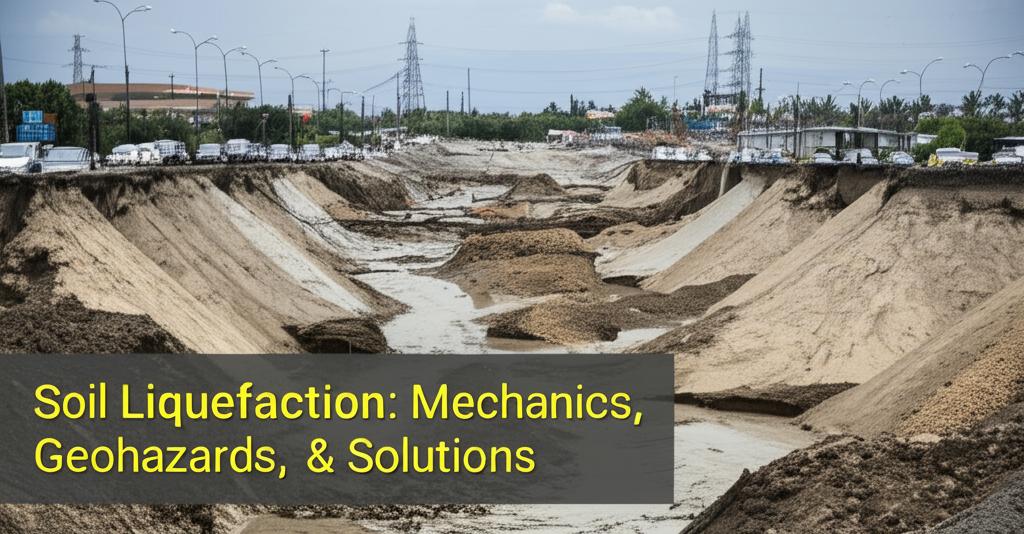Soil liquefaction, a phenomenon where saturated or partially saturated soil loses strength and stiffness, often due to earthquake shaking, can have devastating consequences. This process essentially transforms the soil temporarily into a liquid-like state, reducing its ability to support structures. Understanding its mechanics, associated geohazards, and developing effective solutions are critical areas of ongoing research and engineering practice.
Mechanics of Soil LiquefactionThe fundamental cause of soil liquefaction is the increase in pore water pressure within the soil. When stress, such as seismic shaking, is applied to saturated granular soil, the soil particles attempt to rearrange into a denser configuration. If the water in the pores cannot drain quickly enough, the pressure of the water builds up, counteracting the stress holding the soil particles together. This reduction in effective stress causes the soil to lose its shear strength and behave like a fluid.
Key factors influencing soil liquefaction include:
- Seismic Activity: Earthquakes are the most common triggers.
- Soil Saturation: The soil must be saturated or nearly saturated with water.
- Soil Composition and Properties: Loose, sandy soils with poor drainage are particularly susceptible. The presence and characteristics of fine particles (silts and clays) can also influence liquefaction behavior.
- Intensity and Duration of Shaking: Stronger and longer shaking increases the likelihood and severity of liquefaction.
- Drainage Conditions: Traditionally, liquefaction was associated with undrained conditions near an earthquake's epicenter. However, recent research indicates that liquefaction can also occur under drained conditions, even at lower seismic energy levels and further from the epicenter. This "drained liquefaction" is influenced by seismic shaking facilitating interstitial fluid flow, leading to excess pore pressure gradients and strength loss.
The consequences of soil liquefaction can be severe and widespread:
- Structural Damage: Buildings and infrastructure can tilt, settle unevenly, or even collapse as the ground loses its bearing capacity. This includes damage to foundations, roads, bridges, and underground utilities.
- Ground Deformation: Liquefaction can cause various forms of ground failure, including:
Sand Boils: Ejection of water and sand onto the ground surface.
Lateral Spreading: Horizontal movement of gently sloping ground.
Ground Settlement: Subsidence of the ground surface.
Flow Failures: Large-scale, rapid movement of liquefied soil, often on steeper slopes.
- Environmental and Economic Consequences: Damage to infrastructure can lead to significant economic losses, disruption of essential services, and potential environmental contamination. In severe cases, areas can become uninhabitable.
Addressing soil liquefaction involves a combination of risk assessment, ground improvement techniques, and structural design considerations.
1. Liquefaction Risk Assessment:Identifying and assessing liquefaction risk is a critical first step. This involves:
- Site Investigation: Characterizing soil type, density, groundwater levels, and site seismicity.
- Analytical Methods: Employing methods such as the Simplified Method, Stress-Based Method, Cone Penetration Test (CPT) Method, and Shear Wave Velocity Method.
- Advanced Tools: Utilizing geotechnical software, remote sensing, geophysical techniques (like GPR and ERT), and artificial intelligence (AI) for more precise evaluations and risk mapping. Recent research has also focused on using ambient noise analysis to assess liquefaction potential. Award-winning datasets are aiding in improving liquefaction triggering assessments.
Various techniques aim to improve soil properties and reduce liquefaction susceptibility:
- Densification/Compaction: These methods increase soil density and strength.
Dynamic Compaction: Dropping heavy weights to densify loose granular soils.
Vibro-Compaction: Using vibrating probes to densify loose sandy soils.
Compaction Grouting: Injecting a stiff mortar to displace and densify surrounding soil.
- Soil Reinforcement:
Stone Columns/Vibro Replacement: Installing columns of compacted gravel or crushed stone to improve drainage, increase shear strength, and reduce compressibility.
Deep Mixing Methods (DMM): Mixing soil in-situ with cementitious binders to create soil-cement columns.
Geosynthetics: Using materials like geotextiles and geogrids to reinforce soil.
- Drainage Improvement:
Gravel Drains/Prefabricated Vertical Drains (PVDs): Installing drains to help dissipate excess pore water pressure during an earthquake.
Lowering Groundwater Table: Reducing soil saturation.
- Grouting and Injection:
Polyurethane Injection: Injecting polyurethane resin that expands and binds soil particles, increasing stability (e.g., LiqueLock™ process).
Colloidal Silica Grouting: Injecting colloidal silica grout that gels and binds soil particles.
- Innovative and Emerging Techniques:
Nanomaterials: Using materials like bentonite, laponite, and colloidal silica to reduce liquefaction.
Biological Methods (e.g., MICP): Microbially Induced Calcite Precipitation uses microorganisms to bind soil particles. This is considered an eco-friendly approach.
Recycled Materials: Utilizing construction waste, glass, and rubber chips as sustainable solutions.
Partial Saturation Techniques: Injecting air or biogas to reduce the degree of saturation and improve liquefaction resistance.
* Microfine Cement: For soil stabilization.
3. Structural Design and Retrofitting:- Seismic Design: Designing structures to withstand seismic forces and potential ground deformation.
- Deep Foundations: Using piles or drilled shafts to transfer building loads to deeper, more stable soil layers, reducing risks associated with liquefaction in shallower soils.
- Reinforced Pile Foundations: Offering increased resistance in liquefaction-prone areas.
Regular geotechnical assessments, groundwater level monitoring, and structural inspections are crucial for identifying and addressing potential liquefaction risks proactively.
The field of soil liquefaction engineering is continuously evolving, with ongoing research leading to a better understanding of its mechanisms and more effective mitigation strategies. Recent advancements highlight the importance of considering a spectrum of drainage conditions and the complex interaction between different soil layers. The focus is increasingly on developing sustainable, cost-effective, and environmentally friendly solutions to protect infrastructure and communities from this significant geohazard.

